Atlantis › Roman Triumph » Ancient origins
Articles and Definitions › Contents
- Atlantis › Antique Origins
- Roman Triumph › Ancient History
Ancient civilizations › Historical and archaeological sites
Atlantis › Antique Origins
Definition and Origins
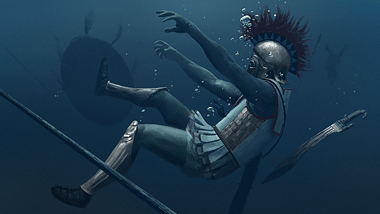
Atlantis is a legendary city which is described in the work of the Greek philosopher Plato (c. 429 – 347 BCE). The story of Atlantis with its fabulously wealthy and advanced civilization which was swept into the sea to be lost for ever has captured the imagination of readers for over two millennia. Without any archaeological evidence or substantial information from sources besides Plato, the legend poses more questions than answers. Was there a real Atlantis? Was the story based on the ancient Minoan civilization ? Was the disaster that swept away the city the eruption of Thera on Santorini in the Aegean, or was the whole story a fiction of Plato's to illustrate the glory of his own city of Athens and provide a moral example of what happened to cities who became greedy and neglected the rule of law? If it had been a real state then who founded it? Why do we know so little about it? Where is it now? These are all questions endlessly speculated by scholars and history enthusiasts without any satisfactory answers ever being reached.
PLATO'S TIMAEUS
The story of Atlantis first appears in Plato's Timaeus, one of his later works. The dialogue's title derives from its protagonist, a fictional Pythagorean philosopher from Southern Italy who discusses the soul with Socrates. This particular dialogue is not a philosophical one, though, but rather an exercise in sophistry and involves an extremely long monologue by Timaeus on the creation of the world. Philosophical ideas are discussed but the age-old question arises of what exactly are Plato's ideas and which are merely those of his characters? The passage on Atlantis is actually spoken early in the dialogue by Critias, a Sophist who lived c. 460 to 403 BCE. Significantly, Critias, like all Sophists (as Plato himself explained in his Phaedrusdialogue), presents his ideas with exaggeration and embellishments to capture the attention of the listener and convey the essence of the ideas only. All is opaque, nothing is exact. Whatever literary means necessary must be taken to express complex philosophical ideas and make them more understandable. It is, perhaps, with this in mind, that one should read the Atlantis myth.
PLATO USES WHATEVER LITERARY MEANS NECESSARY TO BEST EXPRESS HIS PHILOSOPHICAL IDEAS. IT IS, PERHAPS, WITH THIS IN MIND, THAT ONE SHOULD READ THE ATLANTIS MYTH.
Critias' story is introduced by another guest Hermocrates (a historical general from Syracuse ) who urges Critias to tell his story "that goes back a long way" (20d). Critias begins by emphasising his story is true and was vouched for by Solon, the Greek statesman and poet who lived c. 640 - c. 560 BCE. Critias acknowledges his story is "a very strange one, but even so, every word of it is true" (20d). He says that Solon told it to his friend Dropides, Critias' great-grandfather, and it was passed on down the family generations. Solon, we are told, heard the story on his travels in Egypt, specifically by priestly scholars at Sais, and had meant to put it in writing but never found the opportunity. Critias would like to tell the story because it illustrates one of Athens' greatest ever achievements but has, unfortunately, been forgotten over time due to its great antiquity, according to the Egyptian priests, 9,000 years before Plato.
The great achievement of this ancient Athens is described by Critias as he quotes the priest speaking directly to Solon:
The records speak of a vast power that your city once brought to a halt in its insolent march against the whole of Europe and Asia at once - a power that sprang forth from beyond, from the Atlantic Ocean. For at that time this ocean was passable, since it had an island in it in the front of the strait that you people say you call the 'Pillars of Hercules.' [Strait of Gibraltar] This island was larger than Libya and Asia [for the Greeks at that time Asia was the Nile to the Hellespont] combined, and it provided passage to the other islands for people who travelled in those days. From those islands one could then travel to the entire continent on the other side, which surrounds that real sea beyond. Everything here inside the strait we're talking about seems nothing but a harbour with a narrow entrance, whereas that really is an ocean out there and the land that embraces it all the way around truly deserves to be called a continent. Now on this Isle of Atlantis a great and marvellous royal power established itself, and ruled not the whole island, but many of the other islands and parts of the continent as well. What's more, their rule extended even inside the strait, over Libya as far as Egypt, and over Europe as far as Tyrrhenia [central Italy]. Now one day this power gathered all of itself together, and set out to enslave all of the territory inside the strait, including your region and ours, in one fell swoop. Then it was, Solon, that your city's might shone bright with excellence and strength, for all humankind to see. Preeminent among all others in the nobility of her spirit and in her use of all the arts of war she first rose to the leadership of the Greek cause. Later, forced to stand alone, deserted by her allies, she reached a point of extreme peril. Nevertheless, she overcame the invaders and erected her monument of victory. She prevented the enslavement of those not yet enslaved, and generously freed all the rest of us who lived within the boundaries of Hercules. Sometime later excessively violent earthquakes and floods occurred, and after the onset of an unbearable day and a night, your entire warrior force sank below the earth all at once, and the Isle of Atlantis likewise sank below the sea and disappeared. That is how the ocean in that region has come to be even now unnavigable and unexplorable, obstructed as it is by a layer of mud at a shallow depth. The residue of the island as it settled. ( Timaeus, 24e-25e, transl. DJZeyl)
Critias then explains that the previous day's discussion with Socrates (presumably the Republic ) and talk of an ideal city and the political institutions proposed by the great philosopher had reminded him of the story. He then proposes to use the story as a basis of that day's discussion. Socrates agrees as it is just then the celebration of Athens' patron goddess Athena and, further, "it's no made-up story but a true account" (26e), says Socrates. In fact, though, Atlantis is not mentioned again and Timaeus proceeds to give a long speech on the origin of the universe and humanity. None of the other characters speak again.
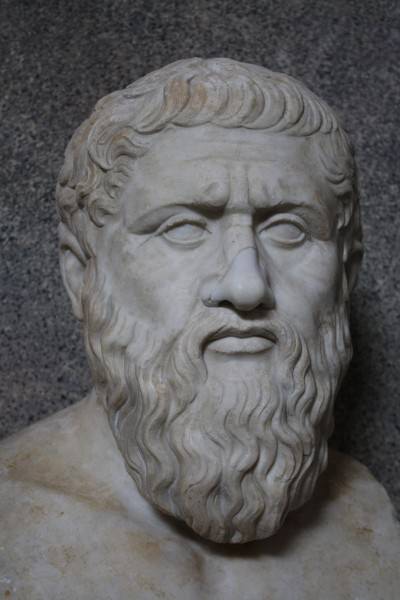
Plato
PLATO'S CRITIAS
The Atlantis story crops up again, this time in more detail, in Plato's Critias, the dialogue named after our story-telling Sophist of the Timaeus. This work follows on from the conversation of Timaeus, and now Critias will present the theories of Socrates' ideal state in the context of a real city, that of Athens 9,000 years ago. He will thus show how these institutions allowed the Athenians to defeat a technologically advanced civilization from Atlantis and prosper thereafter. The dialogue is incomplete as Critias' speech does not go as far as the war between Athens and Atlantis and trails off mid-story, and the fourth character, Hermocrates, does not get his turn to speak, despite Socrates indicating at the beginning that he would.
Critias begins his speech thus,
We should recall at the very beginning that, in very rough terms, it was some 9,000 years since the time when a war is recorded as having broken out between the peoples dwelling outside the pillars of Hercules and all those dwelling within. This war I must now describe. Now they said that this city of Athens was the ruler of the [Mediterranean] peoples and fought for the duration of the entire war. They said, too, that the kings of the island of Atlantis were the rulers of the other peoples. This island, as we were saying [in Timaeus ], was at one time greater than both Libya and Asia combined. But now because of earthquakes it has subsided into the great Ocean and has produced a vast sea of mud that blocks the passage of mariners who would sail into the great Ocean from Greek waters and for this reason it is no longer navigable. ( Critias, 108e-109a, transl. D.Clay)
Atlantis reappears a few pages after a description of how the gods Athena and Hephaistos were given Athens to govern, the early life of that city and her ancient kings:
So it was that Poseidon received as one of his domains the island of Atlantis and he established dwelling places for the children he had fathered of a mortal woman in a certain place on the island I shall describe. ( ibid 113c)
There then follows a lengthy and detailed description of Atlantis. The island was mountainous and rose straight from the sea. It had fertile central plains with a central hill surrounded by rings of sea and land which were created by Poseidon to protect his people. We are told that the first king was Atlas and so the land called Atlantis and the ocean around it the Atlantic. The race prospered over many generations and they conquered the lands around the Mediterranean.
The land of Atlantis produced trees, metals, abundant food, and was inhabited by many creatures, including elephants. The people of Atlantis lived well, they domesticated animals, irrigated their crops, cities were built with harbours and fine temples, bridges and canals with walls and gates were constructed to join the rings of sea around the island. These latter were then decorated with bronze and tin such was the abundance of resources. At the centre of the city was a temple to Poseidon which was faced with silver in its entirety and given a roof of ivory. The whole complex was then surrounded by a wall of pure goldand decorated with golden statues. The city had fountains of hot and cold water, bath houses, gymnasia, a horse racing track, and a huge fleet of warships. The population was enormous and the army could field a force of 10,000 chariots. Religious practices are then described and these involve the chasing and sacrifice of bulls.
Quite simply this race on Atlantis was the most populous, technologically advanced, powerful and prosperous ever seen. Yet their decline would be swift and dramatic:
Yet inwardly they were filled with an unjust lust for possessions and power. But as Zeus, god of the gods, reigning as king according to law, could clearly see this state of affairs, he observed this noble race lying in this abject state and resolved to punish them and to make them more careful and harmonious as a result of their chastisement. To this end he called all the gods to their most honoured abode, which stands at the middle of the universe and looks down upon all that has a share in generation. And when he had gathered them together he said… ( ibid, 121b-c)
And there the story is interrupted and the Critias text ends. We know, though, from the previous references earlier in the Critiasand in the Timaeus that Atlantis was defeated by the Athenians in a war and Atlantis was swept into the sea by earthquakes and floods never to be seen again.

Volcanic Crater of Thera (Santorini)
INTERPRETATION OF ATLANTIS
Plato, then, at least at face value, introduces the story of Atlantis only to show that ancient Athens was a great city and its people with their rule of law were able to defend their liberty against an aggressive foreign power. That, at least, is the intention of Critias, the character. There is certainly a moral side to the story too, that greed for wealth and power will only bring destruction.
As a metaphor, the Atlantis story and Athens' victory may represent the Battle of Marathon in 490 BCE when the Greeks had famously defeated the invading Persian army of Darius. The metaphor of Greeks fighting 'barbarians' represented as mythical creatures such as centaurs was already evident in Greek art prior to Plato. Does the 'forced to stand alone' reference the absence of the Spartans at Marathon perhaps?
And what of the physical location of Atlantis? Many consider the island and its disappearance inspired by the volcanic eruption, earthquakes, and consequent tsunamis on the Aegean island of Thera in the late Bronze Age which destroyed that particular culture and sank most of the island. Thera with its extensive trade network and fine arts would surely have been considered advanced and prosperous by contemporary civilizations. What better way to remember this shocking extinction than by a colourful myth? The sheer mountains description of Atlantis would certainly fit that of a volcanic island but its size and location in the Atlantic do not fit with Thera.
Then there is the mention of chasing and sacrificing bulls in Atlantis. Could this reference the well-documented practice on Minoan Crete where bull jumping, worship, and iconography pervade the archaeological record? Plato's next dialogue, according to many scholars, was (coincidentally?) titled Minos after the island's legendary king, admired by Plato for his law-making skills.
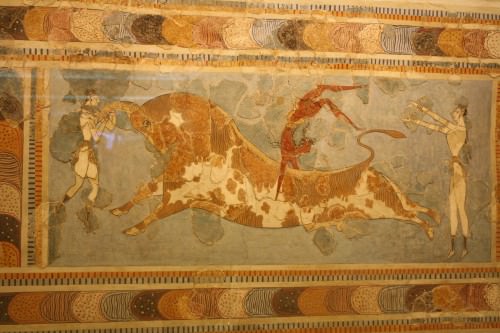
Minoan Bull Leaping
LATER AUTHORS
Other ancient authors after Plato were interested in the tale of Atlantis starting with Crantor (c. 335 -275 BCE). He was a philosopher in Plato's Academy who wrote a celebrated commentary on the Timaeus and held the Atlantis story to be literally true. Atlantis reappears in the work of the Greek biographer Plutarch (c. 45 – c. 125 CE) who reiterates in his biography of Solon that the famous law-giver had wanted to document the story for posterity:
Solon also attempted to write a long poem dealing with the story or legend of the lost Atlantis, because of the subject, according to what he had heard from the learned men of Sais in Egypt, had a special connection with Athens. He finally abandoned it, however, not, as Plato suggests, for lack of time, but rather because of his age and his fear that the task would be too much for him. ( Solon, 75)
And so it goes on over the centuries, through the Renaissance and Francis Bacon's New Atlantis, Thomas More's Utopia, and right up to the present day with countless retellings and embellishments, and theories ranging from the plausible to the ridiculous, posed, debated, rejected, and debated again.
The tale of Atlantis leaves many questions which have only tantalizing hypotheses as answers. Perhaps, then, we would do well to remember that Plato was not a historian but a philosopher, that he frequently used similes and metaphors to express his thoughts, and that, in his own words, delivered from the mouth of Critias: "It is inevitable, I suppose, that everything we have all said is a kind of representation and attempted likeness" ( Critias 107b).
Roman Triumph › Ancient History
Definition and Origins

A Roman triumph was a spectacular victory celebration parade held in the city of Rome for a military commander who had won an important victory on the battlefield. Granted by the Senate, it was a lavish and entertaining propaganda spectacle which reminded the people of the glory of Rome and its military superiority above all other nations. Later, triumphs were reserved for the emperor only but they became ever more extravagant as sometimes unpopular rulers sought to ingratiate themselves with the people of Rome.
ANCIENT SOURCES
Many triumphs, as they were so important to political life and were celebrated over such a long period, were well documented by the Romans, even if later sources were keen to impress the royal household and so are prone to exaggeration. Initially, triumphs were for any senior commander who had performed great military deeds (or been in overall command of those subordinate officers who had) and who had brought his army back to Rome, but in the late Republic rules were often bent, and in the imperial period the privilege became less frequent. This was because the emperor, concerned to keep public affection for himself, made the parade exclusively the right of the royal household.
According to the 5th-century CE historian Orosius, there were 320 triumphs in Rome up to the 1st century CE. We also have a fragmentary list (part of the Fasti Triumphales ) of all the Republic's triumphs, which probably first appeared on the 20 BCE Arch of Augustus in the Roman Forum. Regardless of exactly how many there were, though, when the city did host a triumph it must have been one of the most impressive sights the citizens would see in a city by no means short of entertaining spectacles.
REPUBLICAN TRIUMPHS
Roman historians describe even the early kings as celebrating triumphs, but this is likely pure fiction. The procession may have originally been an entirely religious one (and it did always maintain a religious element) involving the offering of foodstuffs to the fertility god Liber to ensure a good harvest. It may also have been a tradition borrowed from the Etruscans, but evidence is lacking.
STAR OF THE SHOW, THE GOD-LIKE VICTOR WOULD RIDE A SPECTACULAR TALL-SIDED CHARIOT PULLED BY FOUR HORSES IN A LAVISH PROCESSION WHICH WENT THROUGH THE STREETS OF ROME.
The first celebrations of Roman military victories were doubtless much more modest and direct, but from the Punic Wars, a general procedure came to be established. First, a commander might receive from his legions a shouting ovation that he had earned the honorary title of imperator. The general would then send a tablet and laurel wreath (symbolic of victory at the great Olympic Games since the Archaic Period ), known as a litterae laureatae, to the Roman senate. If the senate confirmed the victory and its importance his salutatio imperatoria was likewise confirmed. The commander now had the right to attach laurels to his fasces (the bundle of rods and axe which were the symbol of magisterial authority) and call himself, as an honorary title, Imperator. This he could do until the end of his public triumph (should he be granted one) or until he crossed the Pomerium, the sacred boundary of the city of Rome.
The next step was for the commander to go to Rome in person and wait outside the Pomerium. There he would carry his auspicia militaria, the auspices given to him by the city before his campaign. They could only be returned within the city on the day of his public triumph which he now had to petition the Senate for. Rather than the commander going to the Senate, they came to him and convened in the temple of Bellona to hear his claim. Sometimes there would be much debate, but a charismatic leader considered popular with the people and with influential friends always had a good chance of getting his triumph.
The triumph ceremonies varied each time but many common elements are evident. They generally took up a whole day and started with a speech before breakfast. The victorious commander would speak before the senate, magistrates, his army, and the public. The crowd would first salute him, then after appropriate prayers of thanks had been offered to the gods, he would praise his legions and mention specific individuals for their contributions, give out decorations for valour, and distribute money to his soldiers.
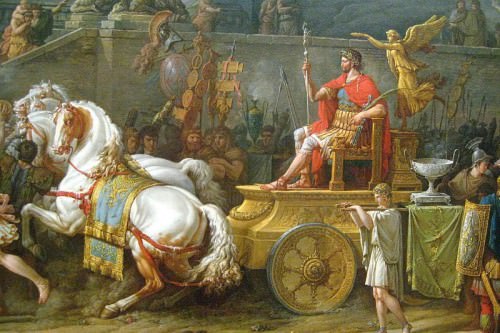
The Triumph of Aemilius Paulus
After breakfast, the victor put on special purple-coloured robes and offered sacrifices to the gods. He was ready for his big moment. The procession entered the city at a specific point, the Porta Triumphalis, a gate used only for that purpose, and then went through the streets and squares of Rome along a route chosen by the commander. The consuls and politicians would lead, followed by a number of impressive-looking captives from the battlefield – best of all would be a captured royal, perhaps theatrically enchained. Certain episodes of the battle might be represented in the procession via paintings or even enactments involving real captives. If the occasion was marking a naval triumph there might be a nautical theme going on with ships' beaks and captured equipment. There were musicians, torch-bearers, and flag wavers to add to the pageantry, as well as examples of the exotic flowers and animals from the conquered region. Next came the war -booty with the more gold and silver on display the better. After that came the lictors (magisterial attendants) who carried the fasces decked with laurel leaves and then the commander himself.
Star of the show, the god-like victor would ride a spectacular tall-sided chariot pulled by four horses. He wore a laurel crown and carried a laurel branch in his right hand. In his left hand, he carried an ivory sceptre with an eagle at the top, symbolic of the triumph. He was accompanied by a slave whose job was to hold above his head a gold crown and continuously whisper in his ear that, amongst all this adoration, he should remember that he was only a mortal and not actually a god. For this reason, he would repeat respice or 'look behind'. After the chariot came the commander's children and officers on horseback. Finally came the troops, who usually sang songs to ward off the jealousy of the gods, and, if there had been any, a crowd of grateful civilians who had won their freedom by the defeat of their enemy in the battle.
THE VICTOR WAS ACCOMPANIED BY A SLAVE WHOSE JOB WAS TO HOLD ABOVE HIS HEAD A GOLD CROWN AND CONTINUOUSLY WHISPER IN HIS EAR RESPICE OR 'LOOK BEHIND'.
When the whole procession reached the temple of Jupiter Optimus Maximus on the Capitoline Hill the commander imperator might magnanimously free a prisoner or two (in the imperial period they were usually killed in the Forum prison en route) and then sacrificed a bull and offered some of the war-booty in honour of Jupiter. He also offered some of his laurel leaves and thus completed the cycle which had begun with his oath of duty before he had set off on campaign. Finally, the VIP guests sat down to a big banquet inside the temple; from the late Republican period a feast might be offered to the general populace too.After the party, a crowd would make sure the commander got home safe and sound after his big day.
OVATIONS
One level down from a triumph was an ovation. This was awarded for victories over easy opponents (fewer than 5,000 casualties) or those deemed lacking in honour such as pirates or slave revolts. The awarding of a mere ovation to Marcus Licinius Crassus after he quelled the Spartacus revolt is an example. An ovation was considered more appropriate for indecisive battles too. Some of the key differences, apart from having less prestige and pomp, were that the commander did not ride a chariot but travelled on horseback or even on foot, soldiers often did not participate, and a sheep was sacrificed at the end of the procession, not a bull. The commander's dress was not particularly special either as he wore the robe of a magistrate and a crown of myrtle, not laurel. Sometimes commanders, after being refused public money and the right to hold an ovation or triumph proper by the Senate, staged their own, smaller scale version on the Alban Mount. There were also one or two people who tried to stage a triumph outside Rome – Albucius in 104 BCE held one in Sardinia and Mark Antony in 34 BCE at Alexandria – but these were considered to be in very poor taste by the ruling elite in Rome.
IMPERIAL TRIUMPHS
As time went on, each triumph became grander than its predecessor and the whole event could spread over several days.This was especially so when commanders like Julius Caesar in 46 BCE and Octavian in 29 BCE actually celebrated multiple triumphs over successive days. Pompey must take credit for ramping up the spectacle as he had three triumphs in 80, 71, and 61 BCE, each more eye-popping than the last. A master of commemorative propaganda, he even went so far as to build Rome's first stone theatre to make sure his glory lived on for centuries to come. Julius Caesar went one better and built a whole forum, and thereafter, funding building work from the spoils of victory became common practice.
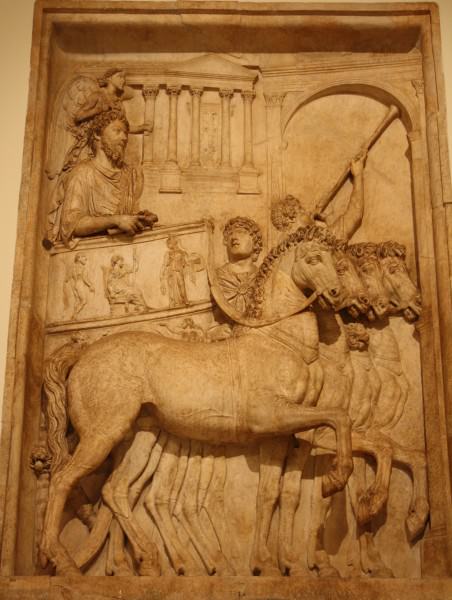
Triumph of Marcus Aurelius
It would be Augustus, though, Rome's first emperor, who had the longest-lasting effect on the institution as he ensured that only the imperial family could bask in the public glory of a triumph. The last non-royal triumph was that of Cornelius Balbus in 19 BCE for his campaigns in Africa, and when Marcus Agrippa actually turned down a triumph in 14 BCE, that more or less set the precedent that this greatest of Roman honours was now a whole lot more exclusive. Augustus instead offered victorious commanders the possibility to wear a laurel crown when they attended games, something which had long been a privilege of those who had received a triumph in the Republican era.
The triumph of Vespasian and his son Titus in 71 CE for their victory in Judaea was notable for its flashy display of the riches from the temple at Jerusalem but, thereafter, triumphs became rare events, fewer than 20 perhaps in the next 200 years.Records are patchy for triumphs in the imperial period but we know that one of the last may have been in 303 CE for Diocletian and Maximian, following their victories in Africa and Britain. Some historians regard the last triumph as that of Belisarius who defeated the Persians and Vandals but that procession was held in Constantinople, not Rome.
In another development in the imperial period triumphs, when they were celebrated at all, they were sometimes done for mere political reasons rather than as marks of military success. In addition, the building of monumental arches became the ultimate, and more long-lasting, way for rulers to commemorate their military victories and personal contribution to the greatness of Rome. A wise decision perhaps, as of all the Romans' buildings, these arches are some of the best surviving monuments of Roman vanity, and they still dominate the urban landscape of many a modern city even after 2,000 years.
LICENSE:
Article based on information obtained from these sources:with permission from the Website Ancient History Encyclopedia
Content is available under License Creative Commons: Attribution-NonCommercial-ShareAlike 3.0 Unported. CC-BY-NC-SA License